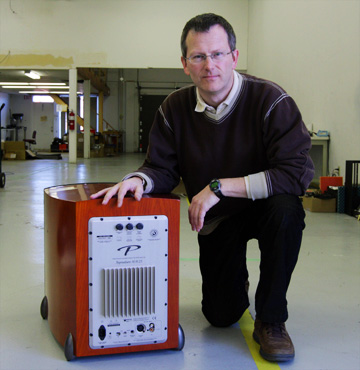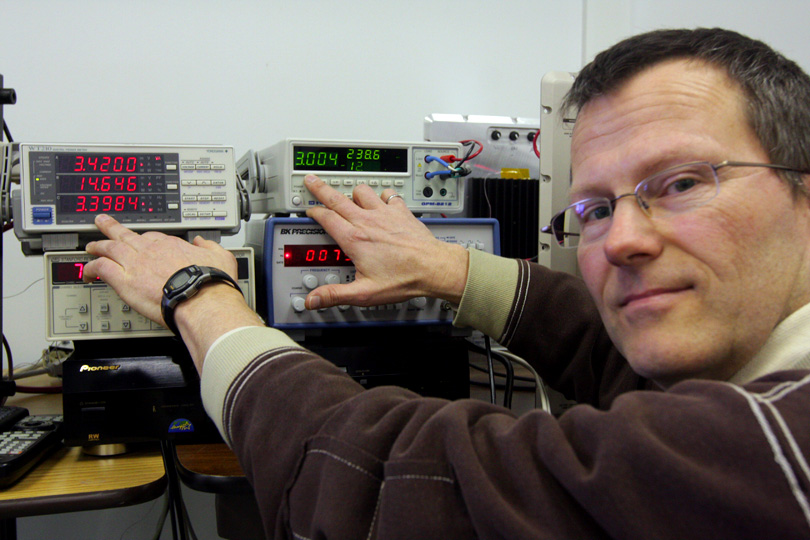December 1, 2009A Powerful Standard

Marc Bonneville at the Paradigm Advanced Research
Centre with the Sub 25.
|
Last month I wrote about parallels between the audio and
watch industries, and finished with a mention of where those similarities end: in
standards of measurement. The watch world has many objective standards, some loose, some
quite strict, and every serious player in the watch business meets at least one of the
well-established regimes that dictate how a watch must perform to be certified by the
governmental body that established that regime. In the audio world, there are no such
universally agreed-on standards of performance.
Who among us hasn’t browsed among what pass for audio
electronics at big-box stores and been pitched by ill-informed saleschildren? Their stock
in trade is to overwhelm the shopper with meaningless but impressive-sounding statistics,
and would you like the extended warranty with that? Some homework for you: Visit your
local electronics shop and ask the saleskid to define Root Mean Square. That’s what
the letters tacked onto amplifier power claims stand far -- as in "100W RMS per
channel." Wikipedia isn’t always the most trustworthy source of information, but
it provides a great definition for RMS: "In mathematics, the root mean square
(abbreviated RMS or rms), also known as the quadratic mean, is a statistical measure of
the magnitude
of a varying quantity." And gobbledygook to you, too.
For our purposes, what we need to know is that the RMS
equation "allow[s] us to calculate the mean power delivered into a specified
load." That’s where we get, say, "100W RMS into an 8-ohm load." In
other words, sticking closely to this definition of RMS, the foregoing power measurement
states that the amplifier is able to deliver a mean power of 100Wpc into an 8-ohm
resistive load. Or does it?
Perhaps the best-known standard of the Swiss watch industry
is the Contrôle Officiel Suisse des Chronomètres (COSC), an official Swiss body that
certifies the time-measuring performance of watch movements. Any watch bearing the words
"Officially Certified Chronometer" has met or exceeded the COSC standards,
which are fairly elaborate and, just as important, universal. That’s because COSC set
its parameters through international agreements with other timing bodies; whether a watch
is certified by COSC, DIN (Germany), or ISO (International) doesn’t matter -- all of
these bodies use the same criteria in measuring performance. Not so with audio
electronics.
The problem with RMS power measurements is that
they’re meaningless. The first problem is that there’s no such thing as
"watts RMS" (it should be volts RMS). The second is that RMS power is typically
measured using a 1kHz sinewave. If all you listen to is a 1kHz tone, then the RMS measure
might be of some value, but most folks tend to listen to music that varies from 20Hz to
20kHz. That variation means that a simple 1kHz test tone reveals only what an amp may be
capable of at that wafer-thin point in the audioband, while telling you nothing about what
the amp can deliver at bass frequencies, where real power is most needed. A third problem
is that the typical test of RMS power is conducted into an 8-ohm load. On the face of it,
that seems reasonable: many speakers are rated at 8-ohms nominal impedance. But here,
again, it’s the real world vs. the test bench: loudspeakers do not present an
amplifier with a single, unified load. Instead, the impedance (load) varies with
frequency; a speaker with a nominal impedance of 8 ohms might present a minimum 3-ohm load
at one frequency and a maximum 9-ohm load at another. But if the test load is an unvarying
8-ohm resistor, well, that’s not much of a test at all.
It’s not hard to understand why many manufacturers
have taken to using watts-RMS as a performance measure -- they had to, to meet a US
standard of amplifier measurement (now defunct) called IHF A202, set by the FTC in 1978.
This measure generates a numerical value that people can easily compare from product to
product, since most performance stats are generated this way. There’s a bonus in that
the numbers are generated at a less-than-taxing 1kHz into a steady load, which means that
this test exaggerates the actual amount of power available to drive speaker loads. For
marketing departments, that means consumers will believe they’re getting more
performance than they really are. Doesn’t everyone like something for nothing?
For the vast majority of makers of audio electronics, the
watts-RMS performance measure is the only one they care to provide to the buying public,
and who can blame them? When companies A and B claim 100W RMS power for their amps using
the 1kHz sinewave measure, but a more scrupulous company, C, claims for its comparable amp
60W of average continuous power but 110W of peak power, it’s not hard to see which
firm is at a competitive disadvantage.
What might surprise some readers is that inflated claims of
wattage are as decried within some parts of the audio industry (and by that I mean
companies whose only line of business is audio gear) as they are, well, here. The best
demonstration of this can be found at SoundStage! V, in the "Paradigm Sub 25 Technology"
videos, Parts 1 through 3. The videos are the result of an extraordinary look inside the
Paradigm Advance Technology Center, where PhDs are paid to dream up the future of speakers
and amplifiers, and which is normally off-limits to the audio press. So when SoundStage!
Network publisher Doug Schneider and I were invited by Dr. Marc Bonneville to see a unique
demonstration of amplifier power, we could hardly say no.
Bonneville came to Paradigm from Canada’s National
Research Council. As a professional scientist, he believes absolutely in honest research,
and by extension, this applies to his work developing products for Paradigm. Like the rest
of us, Paradigm noticed an ever-increasing number of subwoofer models entering the
marketplace accompanied by extraordinary claims for their power output. The problem was
that these output-power calculations were made using the old watts-RMS method, which tells
you little about a full-range amplifier, and nothing at all about a subwoofer amp that may
never be called on to amplify a 150Hz signal, let alone a 1kHz signal. The watts-RMS
methodology is, at best, misleading; using it to calculate the power of a subwoofer amp
seems little more than outright dishonesty.
It turned out that Bonneville’s demonstration
didn’t involve a complete subwoofer, just the amplifier used in the Paradigm
Reference Signature Sub 25. While he was determined to show us that this amp could indeed
produce its claimed 3000W of power, he also wanted to demonstrate that it could produce
enough current (amperage) to move a mountain. What better way to illustrate these
capabilities than to use the amp to simultaneously power a hot-water kettle and a toaster
oven, each drawing from the amp 1500W and 8-10 amps. Those might seem odd ducks to use for
such a test, but think about what a successful outcome would mean: If nothing else, it
would prove that the Sub 25’s amp can push 3000W and large current for minutes
at a time. After all, it takes a lot longer than mere milliseconds -- or even seconds
-- to boil water or toast bread. If the Sub 25’s amp can do both at once, it can
deliver enough continuous, real-world power to simulate an earthquake or two.
The perturbing part of this story is that, on paper,
Paradigm’s 3000W look the same as another company’s 3000W -- even though the
former can produce that kind of power all day long, while the latter might be able to hit
the mark for only milliseconds. And Paradigm’s watts are all there, available to
power the sub’s massive 15" woofer; the other guy’s measurement might well
reflect theoretical performance at a frequency no sub will ever be asked to reproduce.

Marc Bonneville shows the 3000W output that the Sub
25's amplifier is capable of producing.
The watts-RMS specification is as valid for subwoofers as
depth capability is for bicycles. Therefore, no company should use it to misinform
consumers about its products or how they compare to others. One way of eliminating from
the marketplace such apples-and-oranges measurements would be to have every manufacturer
conform to a valid, scientifically devised test regime tailored to the specific type of
component. I don’t think we’ll see anything like the COSC watch certification in
audio any time soon, but I do hold out hope that the European Union might force standards
on any company wishing to do business in the world’s largest trading zone. After all,
if the EU can ban banana plugs, imagine what it could do to deflate false or misleading
claims of amplifier output power.
. . . Colin Smith
editor@goodsound.com
|















